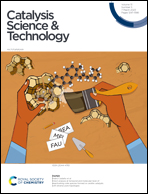Direct analysis at temporal and molecular level of deactivating coke species formed on zeolite catalysts with diverse pore topologies†
Abstract
The mechanistic understanding of coke formation on zeolites is elusive, given the limitations for the extraction and analysis of coke species. Here, we analyze the evolution of deactivating coke species over time on the surface of Ni/ZSM-5, β and Y zeolites during ethylene oligomerization, which is a representative coke-forming reaction. We present a method that directly analyzes the coke species using high-resolution mass spectrometry on the used catalysts and their isolated soluble and insoluble coke fractions (indirect analysis). Along with other techniques, we report a full-picture temporal evolution of coke and its fractions at the molecular level to establish a correlation between the dominant reaction mechanisms, the location of coke within the catalyst structure, and the observed performance of the catalysts. Ab initio calculations are performed to understand the preferable location of coke. We delve deep into the peculiar deactivation mechanism of ZSM-5 zeolite (MFI structure), which shows two less intuitive parallel deactivation pathways.



 Please wait while we load your content...
Please wait while we load your content...